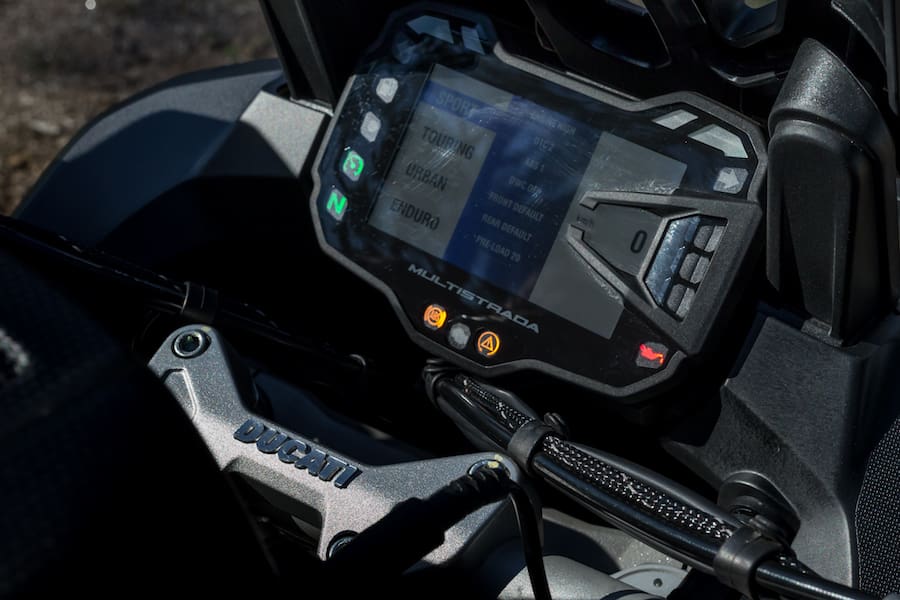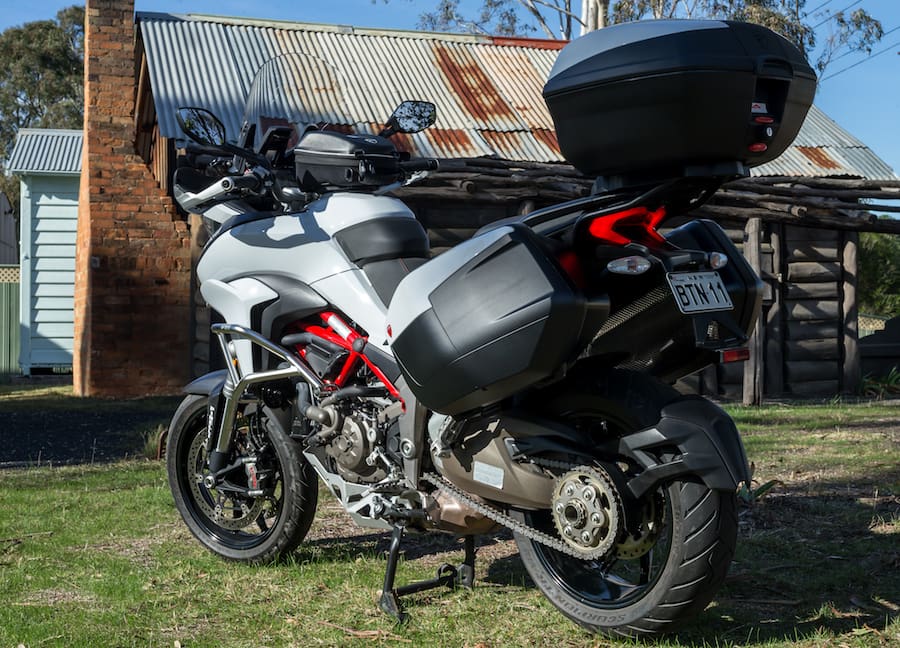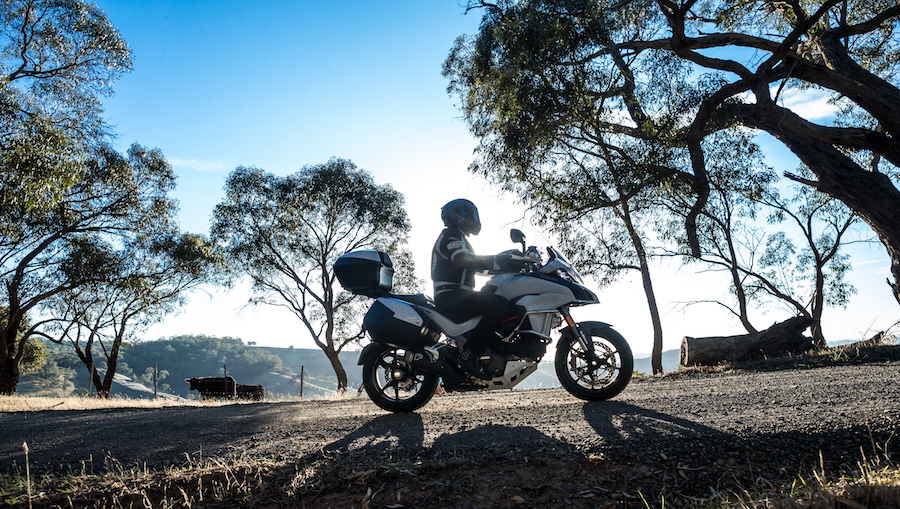How do you properly test Ducati’s four-bikes-in-one Multistrada: in the city, on the open road, on the track or on the gravel? Paul McCann grabbed the keys and said ‘all of the above’
The Multistrada 1200S is the kind of motorcycle that makes you feel grateful. Grateful that we live in an era where these masterpieces of multi-talented engineering are available to the road-going public, and grateful that Ducati has persevered for more than a decade with the big Multi, constantly improving it along the way.
The company’s flagship sports-tourer was unveiled back in 2003 as the 1000DS, and since that time each generation in the series has benefitted from cutting-edge technology to further bolster its versatile design brief. The long-travel fork and eye-catching single-sided aluminium swingarm may have remained constant, but the bike’s DNA has evolved. With the most recent model, Ducati upped the ante again, adding improvements such as Desmodromic Variable Timing (DVT), Bosch’s Inertial Measurement Unit (IMU) and, on the S model, DSS Evo Suspension.
Despite the obvious benefits of having a one-size-fits-all motorcycle, the Multistrada’s four-bikes-in-one approach has divided opinion. After all, how can any generalist hope to come up trumps against competitors with just one specialist tag? Is the big Multi an all-rounder capable of meeting the needs of 90 per cent of our riding requirements, or is it hopelessly incapable of doing any one thing well enough to hold its own against the single-genre bikes it seeks to emulate?
In a somewhat transparent attempt to address this uncertainty, Ducati has created four ‘personalisation’ packages that correspond to the Sport, Enduro, Urban, and Touring modes of the Multistrada’s ride-by-wire engine mapping system.

The Sport pack has a little more bark to accompany the 1198cc V-twin’s bite thanks to its Termignoni slip on, and the kind of bling that always gets appreciated on closer scrutiny. The Urban pack is a commuter’s delight, with lockable tank bag and USB connections, as well as a topbox that allows you to ride without a backpack. The Touring pack is ideal for those who plan on taking advantage of the big Multi’s formidable mile-munching capabilities, with some heavy duty hard panniers, heated grips and a centrestand. Finally, the Enduro pack is designed to provide more reassurance for those tackling soft roads and combines some protective Touratech components such as a radiator guard, bash plate, engine protective bars, broader kickstand plate and off-road pegs, as well as some very trick looking fog lights.
Our test bike, a higher spec ‘S’ model, was endowed with all four packages, so we did what any self-respecting journo would do – we filled the 58-litre side panniers and picked the longest route from the centre of the city pick-up point to the nearest racetrack.
The Multistrada has traditionally been a lofty bike, and for commuting, the long-legged stance and upright riding position is great for vision. This year Ducati has shaved off around 20mm from the seat height and I can see why – it’s tall, even on the lower setting (820mm versus 845mm). At just shy of 6ft it was a welcome change for me to feel a little stretched out, but I can see how some of the vertically challenged among us would struggle when slipping through banked up traffic or constantly coming to a stop on this 230kg-plus bike. However, the seating position is comfortable, and it’s worth remembering that this really comes into its own on the open road – like most of this bike’s attributes.
The S model’s braking system, which includes radially mounted Brembo Monobloc Evo M50 four-piston calipers and Bosch ABS, is incredibly powerful, as is the delivery of the Testastretta V-twin that erupts from this engine at the slightest provocation. In traffic, the Multi explodes off the line and has a loveable habit of lofting the front wheel from the get-go, then repeating this when the revs hit 6000 – almost as if you’ve hit the wheelie button! Of course this can be dampened down by scrolling through the wheelie control settings on the massive five-inch TFT, but why would you when it’s so much a part of the bike’s character, and so predictable.
It’s important to note that this is not a linear, silky smooth in-line four-cylinder engine – as much as the new DVT has improved delivery, it’s still a thumping 1198cc V-twin powerplant, so if you don’t want character and excitement you’d be better off depositing your dough elsewhere.
In the low to midrange, the Testastretta DVT technology makes this Multistrada noticeably smoother and also provides better fuel economy than previous models. It’s almost like the DVT ekes power from places in the rev range that traditionally would have been flat and lifeless on the superseded V-twin engine, and while it still gives some serious vibration through the wide ’bar at very low speed, this becomes a distant memory when the pace hots up and this long-legged stallion goes from canter to full trot. Technically speaking the Urban riding mode with a reduced power output just under 75kW is the Multistrada’s rain setting. It helps a lot in wet conditions to manage the massive amount of torque on tap, but Touring mode, which still has the full 136Nm of torque available, was by far the best option for around town use in the dry.
As a commuter the Multistrada performed well, but it’s a lot of bike in both size and weight, so naturally I was looking for a long stretch in the saddle to relax behind the manually adjustable oversized screen and properly assess its touring credentials. So I was glad when the traffic started thinning and the road started widening on the way north from Melbourne to Broadford.
As I got comfortable on the open road I really felt like the Multistrada was in its element. The only thing limiting touring time is the generous 400-odd kays of distance you can tackle before it’s time to refuel. There’s plenty of space on board for the full complement of luggage (panniers, tank bag and topbox) and a pillion, and the TFT dash allows you to modify the preload settings for a wide variety of luggage and passenger combinations.

When I reached my destination I had the unexpected treat of cutting a few laps on track with the big Multi. With limited time to prepare I flicked the engine mode to Sport, took off the panniers and tank bag, and did a few cursory sighting laps to warm up the Pirelli Scorpion dual-sport tyres that are fitted standard. Their heavy tread pattern and durable construction are not designed for use on track but the plush handling and highly accurate traction control and cornering ABS qualities of the bike made it feel safe and predictable. This may have had something to do with the new Inertial Measurement Unit (IMU) that uses a series of sensors to calculate pitch, roll, and three-dimensional acceleration, which in turn improves the efficacy of Ducati’s semi-active Skyhook Evo suspension and Bosch cornering ABS and DTC, making it hard to lowside.

Given a more open track with long, sweeping bends, the Multistrada might have given smaller sportsbikes a good run for their money, but all in all I was impressed by the responsive power delivery and electronic suspension that made it possible to stiffen up the ride qualities remotely. There’s a relatively intuitive list (hardest, harder, softer, softest and default) to choose from, but the same can’t be said of the controls. While you don’t expect this level of adjustability on a switchblock to be straightforward, it could have been less complicated. Nevertheless, after a bit of practice you can flick through the various engine maps in seconds, and customise your preferences for ABS intervention, wheelie control, TC and front and rear suspension settings without too much head scratching.

Any inconsistencies or performance deficiencies on track vanished when we hit the twisty tarmac spurs that wind their way through the Victorian highlands. The broad ’bars and upright riding position provided maximum flickability in the tight turns, a feature that was followed up with that typical Ducati quality that makes you feel like the bike is planted on any line you choose with just subtle inputs required on the end of either grip.
Off road I was hesitant. Not just because on my limited experience on the loose stuff, but also because of the huge expense of this prestigious motorcycle, and the size and weight that make dabbing your leg a recipe for mangled limbs. However, as I thumbed the map to Enduro and felt the immediate increase in ride height (100mm increase in Enduro mode) I felt confident that the boffins in Bologna had tipped the scales in my favour. The engine protection bars were my final safety net but it never came to that – thankfully. The Scorpions bit into the gravel and the barely noticeable traction control worked overtime to ensure that every bit of power went exactly where it was needed to propel the big Multi on its chosen line without sending the back around or tying itself in knots.

The ABS was an eye-opener, and while I am sure there are many skilled riders who will just roll back the TC and ABS to enhance the fun and excitement, it was nice to know that those without as much off-road experience can still get down and dirty without feeling they’re inches from disaster. The added suspension travel and smoother, restricted top-end power means a long section of undulating gravel track can be navigated in record time on this multidimensional mud puppy.
Yes, the Enduro mode does give you the freedom to go off road, but with these dimensions and weight it’s unlikely that owners will tackle more than a few gravel roads or rocky detours – and to be honest you’d have to be brazen and minted to risk pock-marking that beautiful finish with stone chips or scuffing the ’bar ends during proper trail riding. Ducati clearly recognises that there is a market for more hardcore off-roading and have ticked this box with the release of the Multistrada Enduro.

On the road, the superbike derived V-twin engine and sexy Italian styling are more than enough charm for most, and as a sports-tourer it’s simply a pleasure to ride. If scratching in the hills or the odd trackday is more your bag, the Pikes Peak version might be a better choice, but even in stock trim the Multistrada doesn’t stray far from the fire-breathing racebikes that line up on Superbike grids week in, week out.
As far as possible, Ducati has sharpened every dull edge of the Multistrada from an engineering and technological standpoint and created a truly multi-purpose motorcycle that encourages the rider to take off on an adventure with no restrictions. Of course, it does lend itself to some applications above others, so the personalisation packs come in.
The Multistrada 1200S is the most well-rounded stallion in Ducati’s impressive stable, but the $37,000-plus asking price for the fully loaded option tested here is a lot of bread and honey for even the most pie-eyed Ducatista. In fairness though, no owner would actually fit all four accessory packs straight off the bat, so the aforementioned price gets trimmed down to more competitive figure – impressive considering the calibre of this motorcycle’s components and construction.
So, is the Multistrada really four bikes in one? In short, no, but this class is all about trade-offs, and with that in mind it represents a truly outstanding motorcycle. The Multistrada has more diversity and versatility than any of its competitors, and while it may not be a lightweight single-track trailbike, or a hard-edged elbow scraping racer, it’s got a presence that few other motorcycles can equal.

Stradalling the genres
URBAN PACK: Lockable hard top case with 48-litre capacity, semi-rigid tank bag and power extension cable with USB port RRP: $1,128
TOURING PACK: Heated plug-&-play grips (controlled via the instrument panel), set of 73-litre hard side panniers and centrestand RRP: $1836
SPORT PACK: Termignoni slip on exhaust, carbon-fibre front mudguard, billet aluminium brake and clutch reservoir caps RRP: $1836
ENDURO PACK: Supplementary lights, engine protection bars, radiator guard, oil sump guard, bigger kickstand base and off-road footpegs RRP: $1836
TEST PAUL MCCANN PHOTOGRAPHY MARK DADSWELL

